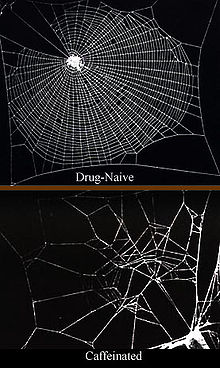Caffeine
Caffeine is a drug (or chemical) that is found in plants. In large amounts it can kill humans and other animals. Even small amounts can kill some animals, such as dogs.
Where caffeine is from
Caffeine is the main drug that is in coffee. Coffee comes from a tree. The seeds of the tree are roasted to make coffee.
Caffeine comes from other plants also. It is found in guarana, yerba maté, cacao, and some plants used to make tea. The plants use caffeine as a pesticide. This is a chemical that kills insects if they eat the plant. It is the way the plant protects itself.
It is called guaranine when it comes from the guarana plant and theine when it comes from a tea plant. It is called mateine in the mate drink. This drink is an infusion made with Yerba mate.
What caffeine is
Caffeine is a stimulant drug. A stimulant is a drug that increases body actions like heart rate, blood pressure, and metabolism. It makes a person feel more awake and alert.
Caffeine also is a diuretic. This means it makes a person make more urine (the waste liquid a person makes).
The caffeine chemical is called a xanthine alkaloid. This is a group of chemicals that are stimulants. Some xanthine alkaloids (like theophylline) are used to help asthma.
What caffeine is used for
The biggest use of caffeine is as a stimulant. People drink coffee and other drinks with caffeine to stay awake.
Doctors sometimes use caffeine as a medicine. It is used for headaches (head pain). It is sometimes used to help premature (born very early) babies to breathe. The short-term risk of this treatment seems to be that the babies treated gain less weight than usual.[1]
Caffeine is sometimes given to people after a lumbar puncture. This is a test to see if someone has meningitis (an infection around the brain).'''
In the beginning caffeine was found to relieve hunger, so it was used for weight loss. That did not last because people were using too much. Caffeine can be a very dangerous drug when not used in the right way.
Caffeine also has medicinal properties. It is used in many over the counter medicines, such as Excedrin, Midol and Anacin. When combined with other analgesics, caffeine can help to alleviate headaches and cramps.
Problems with caffeine

The largest problem with caffeine is addiction. This is when people get bad symptoms when they do not have the drug. When people have withdrawal (feel bad because they do not have the drug) they drink more. This makes them feel better. But if they cannot get more, they are likely to feel some of the symptoms listed below:
Caffeine can also hurt people if they drink very much at once. If someone takes very much of a drug at once it is called an overdose. Caffeine overdose is a medical diagnosis. It is called:Caffeine-Induced Organic Mental Disorder or Caffeine Intoxication. People with this can have these symptoms:
- Very bad feelings like:
- Muscle movements that cannot be stopped
- Very fast heart rate
- Abnormal heart rhythms (even heart stopping)
- Very high blood pressure
- Vomiting
- Confusion (not knowing who the person is or where he/she is)
How much caffeine is safe
250-300 mg of caffeine a day is a moderate amount. This is as much caffeine that is in three cups of coffee (8oz each cup). More than 750-1000mg a day is dangerous. But people who drink more coffee every day can drink more without getting sick. The Lethal Dose 50 of caffeine is 192 mg per kilogram, in rats. In humans, it is between 150 and 200 mg per kilogram.
Caffeine is in many drinks and foods. This is approximate amounts of caffeine in some food and drink:
- Brewed coffee - 40 to 220 mg in a cup
- Instant coffee - 30 to 120 mg in a cup
- Decaffeinated coffee (with much caffeine taken out) - 3 to 5 mg in a cup
- Tea - 20 to 110 mg in a cup
- Soda drinks with caffeine - 36 to 90 mg in 12 ounces
- Milk chocolate - 3 to 6 mg in an ounce
- Bittersweet chocolate - 25 mg in an ounce
One ounce – abbreviated oz - is 30ml.
A 'cup' is 8 oz (240ml.)
References
- ↑ Schmidt, B (May 18 2006). "Caffeine therapy for apnea of prematurity". N Engl J Med. 354 (20): 2112–21.
{{cite journal}}: Check date values in:|date=(help); Unknown parameter|coauthors=ignored (|author=suggested) (help)
